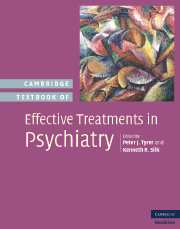Book contents
- Frontmatter
- Contents
- List of contributors
- Preface
- Part I Introduction
- Part II Summary of treatment modalities in psychiatric disorders
- 3 A critical assessment of methods and processes used to develop psychiatric drug treatments
- 4 Section I – The efficacy and safety of electroconvulsive therapy
- 4 Section II – Focal brain stimulation approaches to psychiatric treatment
- 5 The effectiveness of psychological treatments in psychiatry
- 6 Educational interventions
- 7 Complementary and alternative medicine
- 8 Complex interventions
- Part III Specific treatments
- Appendix I Summary of specific drugs having evidence of effectiveness in mental disorders
- Appendix II Key to effectiveness tables
- Index
- References
6 - Educational interventions
from Part II - Summary of treatment modalities in psychiatric disorders
Published online by Cambridge University Press: 12 May 2010
- Frontmatter
- Contents
- List of contributors
- Preface
- Part I Introduction
- Part II Summary of treatment modalities in psychiatric disorders
- 3 A critical assessment of methods and processes used to develop psychiatric drug treatments
- 4 Section I – The efficacy and safety of electroconvulsive therapy
- 4 Section II – Focal brain stimulation approaches to psychiatric treatment
- 5 The effectiveness of psychological treatments in psychiatry
- 6 Educational interventions
- 7 Complementary and alternative medicine
- 8 Complex interventions
- Part III Specific treatments
- Appendix I Summary of specific drugs having evidence of effectiveness in mental disorders
- Appendix II Key to effectiveness tables
- Index
- References
Summary
Editor's note
The place for psycho-education in the treatment of psychiatric disorders appears to be growing. While lip service has often been paid to educational interventions for psychiatric patients, it is really only in the last decade that evidence has been systematically gathered as to its role(s) and effectiveness. Overall educational interventions appear to improve primary care medical workers' (general practitioners, nurse practitioners and the like) detection of, as well as attitudes towards, mental illness, though there is little evidence, with respect especially to ‘milder’ mood disorders, that these interventions change the ultimate outcome of the disorder. Further, they do not, at this time, appear to impact patients' and their families' dislike of pharmacological treatment. Educational interventions in severe and persistent mental illness, especially if patients themselves are involved in the education either as teachers or participants, will reduce stigma towards the illness, but again the reduction in stigma does not translate into better or improved health outcomes. But in severe mental illness, psycho-education, particularly involving problem-solving and motivational interviewing, delivered to patients, other care workers and families appears to reduce rates of relapse and readmission to hospital.
Summary
Educational interventions for mental illness may be provided for patients and carers, the general public or health professionals. They may seek to affect knowledge, skills or attitudes.
With regard to common affective disorders:
There is evidence of effectiveness, particularly in reducing symptoms and severity of depression, for psycho-education delivered to patients through a variety of means.
Public education can change some attitudes towards the illness itself though antipathy to drug treatment appears difficult to alter.
[…]
- Type
- Chapter
- Information
- Cambridge Textbook of Effective Treatments in Psychiatry , pp. 116 - 131Publisher: Cambridge University PressPrint publication year: 2008



